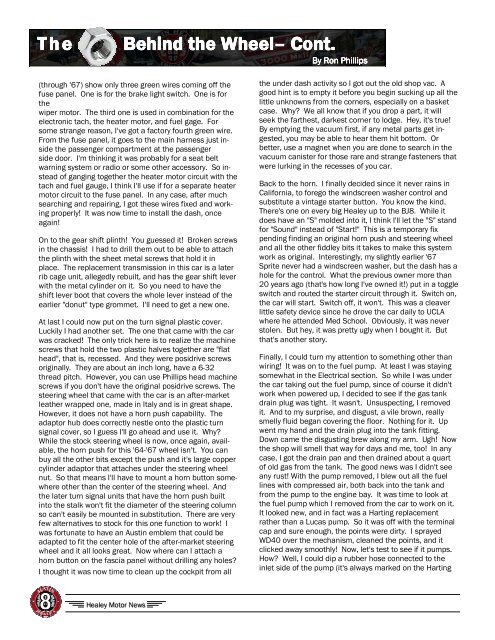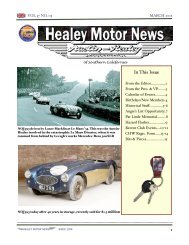Monthly Newsletter - Austin-Healey Association of Southern California
Monthly Newsletter - Austin-Healey Association of Southern California
Monthly Newsletter - Austin-Healey Association of Southern California
You also want an ePaper? Increase the reach of your titles
YUMPU automatically turns print PDFs into web optimized ePapers that Google loves.
The The Behind the Wheel Wheel– Wheel<br />
Cont.<br />
Cont.<br />
(through '67) show only three green wires coming <strong>of</strong>f the<br />
fuse panel. One is for the brake light switch. One is for<br />
the<br />
wiper motor. The third one is used in combination for the<br />
electronic tach, the heater motor, and fuel gage. For<br />
some strange reason, I've got a factory fourth green wire.<br />
From the fuse panel, it goes to the main harness just inside<br />
the passenger compartment at the passenger<br />
side door. I'm thinking it was probably for a seat belt<br />
warning system or radio or some other accessory. So instead<br />
<strong>of</strong> ganging together the heater motor circuit with the<br />
tach and fuel gauge, I think I'll use if for a separate heater<br />
motor circuit to the fuse panel. In any case, after much<br />
searching and repairing, I got these wires fixed and working<br />
properly! It was now time to install the dash, once<br />
again!<br />
On to the gear shift plinth! You guessed it! Broken screws<br />
in the chassis! I had to drill them out to be able to attach<br />
the plinth with the sheet metal screws that hold it in<br />
place. The replacement transmission in this car is a later<br />
rib cage unit, allegedly rebuilt, and has the gear shift lever<br />
with the metal cylinder on it. So you need to have the<br />
shift lever boot that covers the whole lever instead <strong>of</strong> the<br />
earlier "donut" type grommet. I'll need to get a new one.<br />
At last I could now put on the turn signal plastic cover.<br />
Luckily I had another set. The one that came with the car<br />
was cracked! The only trick here is to realize the machine<br />
screws that hold the two plastic halves together are "flat<br />
head", that is, recessed. And they were posidrive screws<br />
originally. They are about an inch long, have a 6-32<br />
thread pitch. However, you can use Phillips head machine<br />
screws if you don't have the original posidrive screws. The<br />
steering wheel that came with the car is an after-market<br />
leather wrapped one, made in Italy and is in great shape.<br />
However, it does not have a horn push capability. The<br />
adaptor hub does correctly nestle onto the plastic turn<br />
signal cover, so I guess I'll go ahead and use it. Why?<br />
While the stock steering wheel is now, once again, available,<br />
the horn push for this '64-'67 wheel isn't. You can<br />
buy all the other bits except the push and it's large copper<br />
cylinder adaptor that attaches under the steering wheel<br />
nut. So that means I'll have to mount a horn button somewhere<br />
other than the center <strong>of</strong> the steering wheel. And<br />
the later turn signal units that have the horn push built<br />
into the stalk won't fit the diameter <strong>of</strong> the steering column<br />
so can't easily be mounted in substitution. There are very<br />
few alternatives to stock for this one function to work! I<br />
was fortunate to have an <strong>Austin</strong> emblem that could be<br />
adapted to fit the center hole <strong>of</strong> the after-market steering<br />
wheel and it all looks great. Now where can I attach a<br />
horn button on the fascia panel without drilling any holes?<br />
I thought it was now time to clean up the cockpit from all<br />
<strong>Healey</strong> Motor News<br />
By By Ron Ron Ron Phillips<br />
Phillips<br />
the under dash activity so I got out the old shop vac. A<br />
good hint is to empty it before you begin sucking up all the<br />
little unknowns from the corners, especially on a basket<br />
case. Why? We all know that if you drop a part, it will<br />
seek the farthest, darkest corner to lodge. Hey, it's true!<br />
By emptying the vacuum first, if any metal parts get ingested,<br />
you may be able to hear them hit bottom. Or<br />
better, use a magnet when you are done to search in the<br />
vacuum canister for those rare and strange fasteners that<br />
were lurking in the recesses <strong>of</strong> you car.<br />
Back to the horn. I finally decided since it never rains in<br />
<strong>California</strong>, to forego the windscreen washer control and<br />
substitute a vintage starter button. You know the kind.<br />
There's one on every big <strong>Healey</strong> up to the BJ8. While it<br />
does have an "S" molded into it, I think I'll let the "S" stand<br />
for "Sound" instead <strong>of</strong> "Start!" This is a temporary fix<br />
pending finding an original horn push and steering wheel<br />
and all the other fiddley bits it takes to make this system<br />
work as original. Interestingly, my slightly earlier '67<br />
Sprite never had a windscreen washer, but the dash has a<br />
hole for the control. What the previous owner more than<br />
20 years ago (that's how long I've owned it!) put in a toggle<br />
switch and routed the starter circuit through it. Switch on,<br />
the car will start. Switch <strong>of</strong>f, it won't. This was a cleaver<br />
little safety device since he drove the car daily to UCLA<br />
where he attended Med School. Obviously, it was never<br />
stolen. But hey, it was pretty ugly when I bought it. But<br />
that's another story.<br />
Finally, I could turn my attention to something other than<br />
wiring! It was on to the fuel pump. At least I was staying<br />
somewhat in the Electrical section. So while I was under<br />
the car taking out the fuel pump, since <strong>of</strong> course it didn't<br />
work when powered up, I decided to see if the gas tank<br />
drain plug was tight. It wasn't. Unsuspecting, I removed<br />
it. And to my surprise, and disgust, a vile brown, really<br />
smelly fluid began covering the floor. Nothing for it. Up<br />
went my hand and the drain plug into the tank fitting.<br />
Down came the disgusting brew along my arm. Ugh! Now<br />
the shop will smell that way for days and me, too! In any<br />
case, I got the drain pan and then drained about a quart<br />
<strong>of</strong> old gas from the tank. The good news was I didn't see<br />
any rust! With the pump removed, I blew out all the fuel<br />
lines with compressed air, both back into the tank and<br />
from the pump to the engine bay. It was time to look at<br />
the fuel pump which I removed from the car to work on it.<br />
It looked new, and in fact was a Harting replacement<br />
rather than a Lucas pump. So it was <strong>of</strong>f with the terminal<br />
cap and sure enough, the points were dirty. I sprayed<br />
WD40 over the mechanism, cleaned the points, and it<br />
clicked away smoothly! Now, let's test to see if it pumps.<br />
How? Well, I could dip a rubber hose connected to the<br />
inlet side <strong>of</strong> the pump (it's always marked on the Harting



